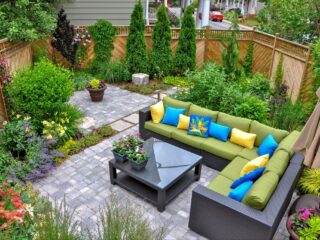
Lawn edging techniques play a crucial role in enhancing the aesthetic appeal and functionality of outdoor spaces. In recent years, there has been a growing interest in eco-friendly alternatives to traditional garden edging methods due to concerns about environmental sustainability.
This article aims to explore the benefits of adopting eco-friendly lawn edging techniques, discuss various types of environmentally conscious materials available for this purpose, provide step-by-step installation guidelines, offer maintenance tips, and present alternative options that promote ecological balance.
Key Takeaways
- Eco-friendly lawn edging techniques help reduce soil erosion.
- They prevent the spread of weeds.
- Eco-friendly lawn edging enhances the aesthetic appeal of the landscape.
- It creates a physical barrier between different areas within the landscape.
Benefits of Eco-Friendly Lawn Edging Techniques
The benefits of eco-friendly lawn edging techniques include reducing soil erosion, preventing the spread of weeds, and enhancing the aesthetic appeal of the landscape. By creating a physical barrier between different areas within the landscape, such as flower beds and lawns, eco-friendly lawn edging techniques help to prevent the loss of topsoil due to water runoff or wind. This reduction in soil erosion preserves the overall health and fertility of the soil, promoting better growth for plants and vegetation.
Additionally, by effectively separating different areas within the landscape, these techniques inhibit weed growth by limiting their ability to spread from one area to another. Moreover, eco-friendly lawn edging techniques enhance the visual appeal of the landscape by providing clean lines and defined borders that create a more polished and organized look. These benefits make eco-friendly lawn edging techniques an essential aspect of sustainable landscaping practices.
As we move on to discuss types of eco-friendly lawn edging materials…
Types of Eco-Friendly Lawn Edging Materials
Among the various options available, different materials can be used for creating environmentally-conscious borders in outdoor spaces. When it comes to eco-friendly lawn edging, several materials stand out for their sustainability and durability. One popular choice is recycled plastic edging, which is made from post-consumer waste such as plastic bottles and containers.
This material not only prevents these items from ending up in landfills but also offers a long-lasting solution for lawn borders. Another option is metal edging, usually made from steel or aluminum, which provides a sleek and modern look while being resistant to corrosion and damage.
Additionally, natural materials like bamboo and wood are also commonly used for eco-friendly lawn edging due to their renewable nature and biodegradability. These different materials offer a range of choices for individuals looking to create sustainable borders around their lawns.
Transitioning into the subsequent section about ‘step-by-step guide to installing eco-friendly lawn edging,’ understanding the various types of eco-friendly materials is essential in making an informed decision regarding suitable options for installation techniques.
Step-by-Step Guide to Installing Eco-Friendly Lawn Edging
One important aspect to consider when installing sustainable borders around lawns is following a step-by-step guide. This ensures that the process is carried out efficiently and effectively, resulting in well-defined and aesthetically pleasing lawn edging. The first step involves outlining the desired perimeter of the lawn, either using spray paint or string.
Next, it is important to remove any existing grass or sod within this marked area using a spade or shovel. After clearing the space, the chosen eco-friendly lawn edging material can be installed, such as recycled plastic or natural stone. This entails placing the edging material along the perimeter and securing it firmly into the ground with stakes or anchors.
Finally, backfilling with soil or gravel and compacting it completes the installation process. By following these steps diligently, one can achieve a professional-looking, eco-friendly lawn border.
This seamless integration of sustainable borders requires regular maintenance to ensure their longevity and effectiveness. Therefore, implementing proper care techniques becomes crucial after installation.
Maintenance Tips for Eco-Friendly Lawn Edging
Implementing regular maintenance practices is essential for ensuring the longevity and effectiveness of sustainable borders around lawns. To maintain eco-friendly lawn edging, consider the following:
- Weeding: Regularly remove weeds from the area surrounding the edging to prevent them from encroaching on the lawn and undermining its overall health.
- Trimming: Trim any overgrown grass or vegetation along the edges of the lawn to maintain a neat appearance and prevent it from overtaking the edging material.
- Cleaning: Clear away any debris or dirt that may accumulate in or around the edging. This will help improve visual appeal and prevent potential damage.
- Inspection: Regularly inspect your eco-friendly lawn edging for any signs of wear, damage, or shifting. Address these issues promptly to avoid further complications.
Eco-Friendly Alternatives to Traditional Lawn Edging Methods
An exploration of sustainable options for borders around lawns reveals alternatives to traditional methods. Traditional lawn edging methods often involve the use of materials such as plastic, metal, or concrete, which can have negative environmental impacts.
However, there are eco-friendly alternatives available that aim to minimize these impacts. One option is using natural materials like wood or stone to create borders around lawns. These materials are biodegradable and have a lower carbon footprint compared to their synthetic counterparts. Another alternative is employing living edging techniques such as planting low-growing plants or using hedges as natural borders.
These living edging methods not only provide a visually appealing border but also promote biodiversity and contribute positively to the ecosystem. Additionally, considering permeable edging options can help prevent water runoff and improve soil health by allowing water infiltration and reducing erosion. Overall, these sustainable alternatives offer environmentally friendly solutions for creating borders around lawns while minimizing the negative impact on the planet.
Conclusion
In conclusion, adopting eco-friendly lawn edging techniques not only benefits the environment but also enhances the overall aesthetic appeal of your lawn. By utilizing sustainable materials such as recycled plastic or natural stone, you can create a beautiful and environmentally conscious landscape.
Following a step-by-step guide for installation and implementing regular maintenance practices will ensure long-lasting results. Moreover, exploring alternative options to traditional lawn edging methods allows for creativity and innovation in gardening practices. “A greener tomorrow starts with our choices today.” ‘A greener tomorrow starts with our choices today, as we strive to create sustainable and eco-friendly landscapes.’








